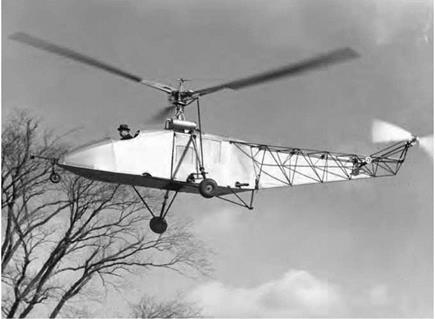NACA-NASA and the Rotary Wing Revolution
John F. Ward
The NACA and NASA have always had a strong interest in promoting Vertical/Short Take-Off and Landing (V/STOL) flight, particularly those systems that make use of rotary wings: helicopters, autogiros, and tilt rotors. New structural materials, advanced propulsion concepts, and the advent of fly-by-wire technology influenced emergent rotary wing technology Work by researchers in various Centers, often in partnership with the military, enabled the United States to achieve dominance in the design and development of advanced military and civilian rotary wing aircraft systems, and continues to address important developments in this field.
F WORLD WAR I LAUNCHED THE FIXED WING AIRCRAFT INDUSTRY, the Second World War triggered the rotary wing revolution and sowed the seeds of the modern American helicopter industry. The interwar years had witnessed the development of the autogiro, an important short takeoff and landing (STOL) predecessor to the helicopter, but one incapable of true vertical flight, or hovering in flight. The rudimentary helicopter appeared at the end of the interwar era, both in Europe and America. In the United States, the Sikorsky R-4 was the first and only production helicopter used in United States’ military operations during the Second World War. R-4 production started in 1943 as a direct outgrowth of the predecessor, VS-300, the first practical American helicopter, which Igor Sikorsky had refined by the end of 1942. That same year, the American Helicopter Society (AHS) was chartered as a professional engineering society representing the rotary wing industry. Also in 1943, the Civil Aeronautics Administration (CAA), forerunner of the Federal Aviation Administration (FAA), issued Aircraft Engineering Division Report No. 32, "Proposed Rotorcraft Airworthiness.” Thus was America’s rotary wing industry birthed.[268]
|
Igor Sikorsky flying the experimental VS-300. Sikorsky. |
As a result of the industry’s growth spurred by continued military demand during the Korean war and the Vietnam conflict, interest in helicopters grew almost exponentially. As a result of the boost in demand for helicopters, Sikorsky Aircraft, Bell Helicopter, Piasecki Helicopter (which evolved into Vertol Aircraft Corporation in 1956, becoming the Vertol Division of the Boeing Company in 1960), Kaman Aircraft, Hughes Helicopter, and Hiller Aircraft entered design evaluations and prototype production contracts with the Department of Defense. Over the past 65 years, the rotary wing industry has become a vital sector of the world aviation system. Types of private, commercial and military utilization abound using aircraft designs of increasing capability, efficiency, reliability, and safety. Helicopters have now been joined by the military V-22, the first operational tilt rotor, and emerging rotary wing unmanned aerial vehicles (UAV), with both successful rotary wing concepts having potential civil applications. Over the past 78 years, the National Advisory Committee for Aeronautics (NACA) and its successor, the National Aeronautics and Space Administration (NASA), have made significant research and technology contributions to the rotary wing revolution, as evidenced by numerous technical publications on rotary wing research testing, database analysis, and theoretical developments published since the 1930s. These technical
resources have made significant contributions to the Nation’s aircraft industry, military services, and private and commercial enterprises.











